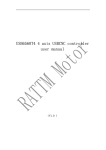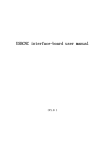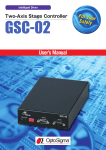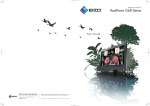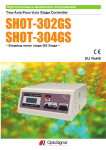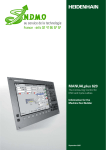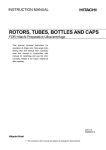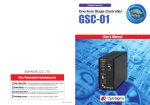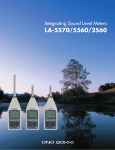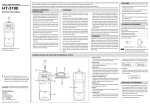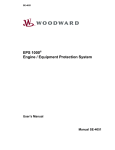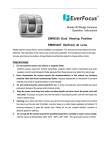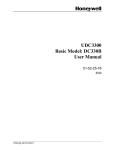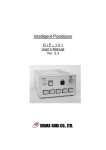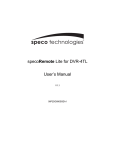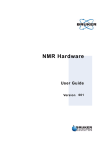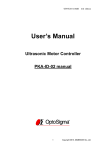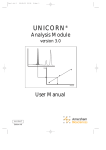Download User`s Manual - OptoSigma Global Top
Transcript
Intelligent Driver Two-Axis Stage Controller User's Manual 1-19-9, Midori, SIGMA KOKI Tokyo Head office, Sumida-ku, Tokyo 130-0021, JAPAN Tel: +81-3-5638-8228 Fax: +81-3-5638-6550 E-mail:sales @sigma-koki.com Osaka Branch 4-9-28, Nishi-Nakajima, Yodogawa-ku, Osaka 532-0011, JAPAN Tel: +81-6-6307-4835 Fax: +81-6-6307-4834 E-mail:sales.osaka @sigma-koki.com Kyushu Sales office 3-17, Hie-machi, Hakata-ku, Fukuoka-shi, Fukuoka 812-0014, JAPAN Tel: +81-92-481-4300 Fax: +81-92-481-4310 E-mail:sales.kyushu @sigma-koki.com 1-1 Yatsukaho, Hakusan-shi, Ishikawa Tel: +81-76-274-6100 Fax: +81-76-274-6103 924-0838, JAPAN 2010.11. Fourth edition Table of Contents For your safety ‥ ‥‥‥‥‥‥‥‥‥‥‥‥‥‥‥‥‥‥‥‥‥‥‥‥‥‥‥‥‥‥‥ 1 Section 1: Before Using Your SHOT-602‥ ‥‥‥‥‥‥‥‥‥‥‥‥‥‥‥‥‥‥ 2 1-1. Check Inside the Package‥‥‥‥‥‥‥‥‥‥‥‥‥‥‥‥‥‥‥‥‥‥‥‥ 2 1-2. Outline‥ ‥‥‥‥‥‥‥‥‥‥‥‥‥‥‥‥‥‥‥‥‥‥‥‥‥‥‥‥‥‥‥ 3 1-3. SHOT-602 System Diagram‥‥‥‥‥‥‥‥‥‥‥‥‥‥‥‥‥‥‥‥‥‥‥ 3 1-4. Names and Functions of Each Part‥‥‥‥‥‥‥‥‥‥‥‥‥‥‥‥‥‥‥‥ 4 Section 2: Basic Operations‥ ‥‥‥‥‥‥‥‥‥‥‥‥‥‥‥‥‥‥‥‥‥‥‥‥‥ 6 2-1. Initialize SHOT-602‥‥‥‥‥‥‥‥‥‥‥‥‥‥‥‥‥‥‥‥‥‥‥‥‥‥‥ 6 2-2. Set Parameters with DIP Switch‥ ‥‥‥‥‥‥‥‥‥‥‥‥‥‥‥‥‥‥‥‥ 6 2-3. Adjust Drive (RUN, STOP) Current‥‥‥‥‥‥‥‥‥‥‥‥‥‥‥‥‥‥‥‥ 7 2-4. Connection between SHOT602 and Motorized Stage‥‥‥‥‥‥‥‥‥‥‥‥ 7 2-5. Connection between SHOT602 and Host (PC, etc) ‥‥‥‥‥‥‥‥‥‥‥‥‥ 7 2-6. Environment Settings of Host ‥‥‥‥‥‥‥‥‥‥‥‥‥‥‥‥‥‥‥‥‥‥ 8 2-7. Power ON and Check Communications ‥ ‥‥‥‥‥‥‥‥‥‥‥‥‥‥‥‥ 8 Section 3: Commands for SHOT-602‥ ‥‥‥‥‥‥‥‥‥‥‥‥‥‥‥‥‥‥‥‥ 9 3-1. Command List‥‥‥‥‥‥‥‥‥‥‥‥‥‥‥‥‥‥‥‥‥‥‥‥‥‥‥‥‥ 9 3-2. Function and Format of Command‥ ‥‥‥‥‥‥‥‥‥‥‥‥‥‥‥‥‥‥‥ 9 Section 4: Specifications‥‥‥‥‥‥‥‥‥‥‥‥‥‥‥‥‥‥‥‥‥‥‥‥‥‥ 13 4-1. General specifications‥‥‥‥‥‥‥‥‥‥‥‥‥‥‥‥‥‥‥‥‥‥‥‥‥ 13 4-2. Performances‥ ‥‥‥‥‥‥‥‥‥‥‥‥‥‥‥‥‥‥‥‥‥‥‥‥‥‥‥ 14 4-3. SHOT-602 Case Drawing‥‥‥‥‥‥‥‥‥‥‥‥‥‥‥‥‥‥‥‥‥‥‥ 15 ■ SHOT-602 User’s Manual ■ For Your Safety ◦ Before using this product, read this manual and all warnings or cautions in the documentation provided. ◦ Only Factory Authorized Personnel should be changes and/or adjust the parts of controller. The Symbols Used in This Manual WARNING CAUTION This symbol marks warnings that should be read and used to prevent serious injury or death. This symbol indicates where caution should be used to avoid possible injury to yourself or others, or damage to property. The above indications are used together with the following symbols to indicate the exact nature of the warning or caution. Examples of Symbols Accompanying Warnings and Cautions △ Symbols enclosed in a triangle indicate warnings and cautions. The exact nature of the warning or caution is indicated by the symbol inside (the symbol at left indicates risk of electrocution). ○ Symbols enclosed in a circle mark indicate prohibitions (actions that must not be performed). The exact nature of the prohibition is indicates by the symbol inside or next to the circle mark (the symbol at left indicates that the product must not be disassembled). ● Symbols inside a black circle mark actions that must be performed to ensure safety. The exact nature of the action that must be performed is indicated by the symbol inside (the symbol at left is used in cases in which the AC adapter must be unplugged to ensure safety). Symbols on the product The symbol mark on the product calls your attention. Please refer to the manual, in the case that you operate the part of the symbol mark on the product. This symbol labeled on the portion calls your attention. Symbols Used in This Manual The following symbols are used in this manual. This symbol is used to indicate cross-references to relevant information in this manual or other documentation. This symbol marks items that should be confirmed before an operation (or action) is performed. This symbol marks definitions of terms and other useful information. (Note) This symbol marks supplementary information. Disclaimer of Liability ① ② ③ ④ SIGMA KOKI CO., LTD. does not accept liability for damages resulting from the use of this product or the inability to use this product. SIGMA KOKI CO., LTD. does not accept liability for damages resulting from the use of this product that deviates from that described in the manual. SIGMA KOKI CO., LTD. does not accept liability for damages resulting from the use of this product in extraordinary conditions, including fire, earthquakes, and other acts of God, action by any third party, other accidents, and deliberate or accidental misuse. If the equipment is used in a manner not specified by the SIGMA KOKI CO., LTD., the protection provided by the equipment may be impaired. WARNING CAUTION ◦ Do not use this product in the presence of flammable gas, explosives, or corrosive substances, in areas exposed to high levels of moisture or humidity, in poorly ventilated areas, or near flammable materials. ◦ Do not connect or check the product while the power is on. ◦ Installation and connection should be performed only by a qualified technician. ◦ Do not bend, pull, damage, or modify the power or connecting cables. ◦ Do not touch the products internal parts. ◦ Connect the earth terminal to ground. ◦ Should the product overheat, or should you notice an unusual smell, heat, or unusual noises coming from the product, turn off the power immediately. ◦ Do not turn on the power in the event that it has received a strong physical shock as the result of a fall or other accident. ◦ Do not touch the stage while operation. ◦ Use dry clothes only for cleaning the equipment. 1 ◦ Do not leave the product in an enclosed area or in areas in which it would be exposed to direct sunlight or vibration. ◦ Do not touch the product when your hands are wet. ◦ When unplugging the product, pull on the plug rather than the cord. ◦ Because some electrical change remains after the power has been cut, do not touch the input or output terminals for ten seconds after the product has been turned off. ◦ When connecting peripherals to the product, adjust the product's initial setting (parameter settings) to suit the peripheral. ◦ Turn off the power before connecting the product to other devices. Connection should be performed following the connection diagram. ◦ Before turning the equipment on (or when beginning operations), be sure that you can turn the power off immediately in the event that an abnormality should occur. ◦ Do not obstruct the product's air vents or other openings. ◦ For continued protection against risk of fire, replace only with same type and rating fuse. Fuse replacement is done by a qualified technician. Tokyo Head office Tel:+81-3-5638-8228 Fax:+81-3-5638-6550 E-mail:[email protected] ■ SHOT-602 User’s Manual ■ Section 1: Before Using Your SHOT-602 1-1 Check Inside the Package Before you use this controller, check if your package includes all the items listed below. It is convenient to check in the boxes: If your package does not include all the items, or items are damaged, please contact us. □ SHOT-602 Stage Controller Unit : 1 □ PC-5K Terminal Cap : 1 Tel:+81-6-6307-4835 Fax:+81-6-6307-4834 E-mail:[email protected] Osaka branch □ Instruction Manual (This Manual) : 1 2 ■ SHOT-602 User’s Manual ■ 1-2 Outline This controller is a twin-axis stage controller featuring stepping motor drivers. Keeping compatibility with existing models, the controller features versatility that can support wide variety of your needs as well as delightfully low price. Connect the unit to your standard PC via RS-232C interface, and you can send simple commands from PC for moving motorized stages precisely to a target position. Simple programming offered allows you to easily configure a controlling system of considerable scale. 1-3 SHOT-602 System Diagram SHOT-602 incorporates stepping motor drivers, which enable you to design a low cost, spaceefficient system with our SGSP series or other motorized stages driven by stepping motors, connected with standard cables. SHOT-602 System Diagram Note that applicable cables and drive current values are depending on the specifications of stages used. Check if your controller can adequately control desired devices before forming a system. You cannot connect SCT-602(PC-5K)and PC to a SHOT-602 controller at the same time. If you connect them in parallel, SHOT-602, SCT-602(PC-5K), and/or PC may be damaged. 3 Tokyo Head office Tel:+81-3-5638-8228 Fax:+81-3-5638-6550 E-mail:[email protected] ■ SHOT-602 User’s Manual ■ 1-4 Names and Functions of Each Part Functions ① Turn ON the power switch (turn to“|”mark) to supply power and light up LED indicator ④ . Turn the switchto OFF “O” ( ) to turn OFF the power and the indicator. and the indicator. ② Use when you want to use your PC for controlling via RS-232C interface. ③ Use when controlling with the PC-5K intelligent controller. ④ Lights up in green while the power is turned ON. ⑤ Lights up in red while driving stages. ⑥ Should be grounded properly in your environment. ⑦ Connect a stage used as Axis 1. ⑧ Connect a stage used as Axis 2. Tel:+81-6-6307-4835 Fax:+81-6-6307-4834 E-mail:[email protected] Osaka branch 4 ■ SHOT-602 User’s Manual ■ ⑨ Makes basic settings for your SHOT-602. ⑩ Volume control adjusting the RUN current output through the stage drive connector (Axis 1). ⑪ Volume control adjusting the STOP current output through the stage drive connector (Axis 1). ⑫ Volume control adjusting the RUN current output through the stage drive connector (Axis 2). ⑬ Volume control adjusting the STOP current output through the stage drive connector (Axis 2). 5 Tokyo Head office Tel:+81-3-5638-8228 Fax:+81-3-5638-6550 E-mail:[email protected] ■ SHOT-602 User’s Manual ■ Section 2: Basic Operations 2-1 Initialize SHOT-602 Initialize your SHOT-602 to match to the target stages and host environment (your PC, etc). The initialization includes DIP switch settings and current adjustments (RUN/STOP) for each axis motor. 2-2 Set Parameters with DIP Switch Initialize your SHOT-602 by setting each switch to ON/OFF as follows: Parameter Assignment in the DIP Switch: DIP switch No. Items Parameters 1,2 Baud rate 2400/4800/9600/19200 3 Detecting the mechanical origin SIGMA system / MINI system 4 Input logic for the limit sensor Normal open / Normal close 5 Specify whether to return to mechanical origin for each axis First axis only / Both axis Switch Settings and Corresponding Parameters (Set to ON by turning to the number-marked side on the switch body) Items Dip switch No. SW2 Baud rate Descriptions SW1 ON ON 2400 ON OFF 4800 OFF ON 9600 OFF OFF 19200 SW3 Detecting the mechanical origin ON SIGMA method OFF MINI method SW4 Input logic for the limit sensor Specify whether to return to mechanical origin for each axis ON Normal open OFF Normal close SW5 ON First axis only OFF Axes1 and 2 NOTE: Shaded areas in the list show our factory settings. Take care to handle the very small DIP switch so as to avoid giving damage to them during the settings. Use appropriate tools such as sharp tweezers for setting switches on the DIP switch. For our SGSP series stages, select Normal Close for the limit sensor logic and MINI for the homing method. See Detection of Machine Home Position in p.10 for the details of the homing method. Tel:+81-6-6307-4835 Fax:+81-6-6307-4834 E-mail:[email protected] Osaka branch 6 ■ SHOT-602 User’s Manual ■ 2-3 Adjust Drive (RUN, STOP) Current Set current values supplied from SHOT-602 to stages. Turn a RUN current volume, provided on the side of the unit, to adjust RUN current corresponding to the stages to use. Use a STOP current volume to set a ratio to RUN current according to your conditions for the case where the current down function works. You can make each current adjustment for Axis 1 or Axis 2 independently. Note that for the STOP current, adjustment is available not for current values, but for a ratio (%) to the RUN current. Note: Generally the ratio of the STOP current to the RUN current is approx. 50 %. Driving current settings (RUN) Volume No 0 1 2 3 4 5 6 7 8 9 10 Amperage 〔A〕 0.17 0.25 0.33 0.40 0.47 0.54 0.61 0.67 0.73 0.79 0.85 Stop current settings(Stop current setting to 50% for RUN current) RUN volume No 0 1 2 3 4 5 6 7 8 9 10 STOP volume No. 0 1 1 1 1 1 2 2 2 2 2 Note: Each value cited in the above table is a guide to adjust the current without instruments, and may fluctuate within an allowable range. Shaded values in the list are factory settings. (Example) Volume setting (Set to"5"in this figure). 2-4 Connection between SHOT-602 and Motorized Stage Connect SHOT-602 to motorized stages. Procedure: ① First, make sure that the power plug of SHOT-602 is removed from the receptacle, and its power switch is turned OFF. Follow this step exactly to avoid possible electric shocks or damage to your unit. ② Connect the cable to motorized stages. Select cables correctly matching to your SHOT-602 and stages. DMINISCA or DBCS series cables are applicable to SHOT-602. ③ Connect the stage for Axis 1 to STAGE 1 connector on SHOT-602. Connect the stage for Axis 2 to STAGE 2. If you want to use only one axis, use STAGE 1 for the connection. 2-5 Connection between SHOT-602 and Host (PC, etc) Connect SHOT-602 and Host (PC, etc) to send/receive controlling commands. Two types of interfaces are available; RS232C and the PC-5K intelligent controller. The following descriptions premise the RS232C interface. Procedure: ① Use a genuine cable RS232C/STR, or 9-pin, D-SUB straight cable with male/female ends using inch screw threads. ② Make sure the power is turned OFF on both PC and SHOT-602. ③ Insert the male connector of the communications cable into the RS232C terminal on the SHOT-602. ④ Insert the female end into the serial port on your PC. You should select only one of RS232C and the PC-5K interface as your interface for the connection. Connecting your units to both interface connectors may damage the units. When you are not using the PC-5K terminal, cover it with the attached cap. See the instructions manual of PC-5K for the details. 7 Tokyo Head office Tel:+81-3-5638-8228 Fax:+81-3-5638-6550 E-mail:[email protected] ■ SHOT-602 User’s Manual ■ 2-6 Environment Settings of Host Configure communications environment on the host for communicating with SHOT-602. The following descriptions use Windows HyperTerminal as the example. For the details of configuration and operations of the HyperTerminal, see the descriptions in the Appendix of this manual or applicable Windows manual. Set Communications Environment: Items Descriptions Bits/second Baud rate set with DIP switch Data Bit 8bits Parity None Stop Bit 1bit Flow Control Hardware Emulation Automatic detection Delimiter(newline character at the end of a line) Insert(CR+LF) 2-7 Power ON and Check Communications When you have completed procedures above, connect the power plug of the SHOT-602 to the receptacle, and turn ON the power switch (turn to“|”mark). SHOT-602 is turned ON and the green power indicator LED lights up. Next, enable communications using the HyperTerminal. Press“Q:”on your key board, and check that“0, 0, K,K,R”appears on the display. If other characters than the above are displayed, turn OFF the power for SHOT-602 and check if settings with the DIP switch coincide with the configuration of the communications software on the host. HyperTerminal Display (typical display of successful communications) Now the setup has been done, and your SHOT-602 is ready to use. For the details of commands applicable to SHOT-602, see Section 3: Commands for SHOT-602. Tel:+81-6-6307-4835 Fax:+81-6-6307-4834 E-mail:[email protected] Osaka branch 8 ■ SHOT-602 User’s Manual ■ Section 3: Commands for SHOT-602 3-1 Command List Listed below are all the commands used with SHOT-602: Command String Details Return to mechanical origin H: Detect mechanical origin Set electronic(logical)origin R: Set the electronic(logical)origin to the current position Speed settings D: Set S, F, and R Set number of pulses forrelative movement M: Axis of movement, direction, number of pulses Jog command J: Move at minimum speed (S) Drive command G Start Stop L: Stop or reduce speed Free motor C: Excitation ON/OFF Status1 Q: Return current position etc. Status2 !: Return B (Busy)/R (Ready) Internal information ?: Check internal information NOTE: Only“G”command does not have a colon(“:”)at the end. 3-2 Function and Format of Command SHOT-602 uses upper-case, one-byte characters. Except for some status check commands, no response will be returned to a command input. Some commands need parameters. 1) Control (drive system) Command 1 (1) H command: Machine Home Return Command Function: Detects the machine zero on the stage, and define the position as the home position. Detection of a machine zero sets the display to“0.” To detect the zero, each axis moves at the following constant conditions: Minimum speed (S): 500 pps, Maximum speed (F): 5000 pps, Acceleration/Deceleration time (R): 200 ms. Axes to home are depending on the DIP switch settings. Format: H:[Axis number to home][Direction of the Axis 1] H:W[Direction of Axis 1][Direction of Axis 2] Returns only one axis to home position. Returns both axes to home position. Use parameters“1”or“2”to specify each axis. For both axes, write“W.”Use“+”or“-”as direction parameters. Do not insert a space, etc. between parameters. [Example 1] H:1+ Detects machine zero for Axis 1 in the positive direction. [Example 2] H:1- Detects machine zero for Axis 1 in the negative direction. [Example 3] H:2+ Detects machine zero for Axis 2 in the positive direction. [Example 4] H:2- Detects machine zero for Axis 2 in the negative direction. [Example 5] H:W++ Detects machine zero for Axes 1 and 2, both in the positive direction. [Example 6] H:W+- Detects machine zero for Axis 1 in the positive direction, and Axis 2 in the negative direction. [Example 7] H:W-+ Detects machine zero for Axis 1 in the negative direction, Axis 2 in the positive direction. [Example 8] H:W-- Detects machine zero for Axes 1 and 2, both in the negative direction. Note: With“H:W,” “L:1”or“L:2”practically means“L:E.” 9 Tokyo Head office Tel:+81-3-5638-8228 Fax:+81-3-5638-6550 E-mail:[email protected] ■ SHOT-602 User’s Manual ■ Detecting the Mechanical Origin MARK (Sigma) system When the command is given to detect the mechanical origin, the stage begins moving clockwise (i.e., in the -direction) at 5000pps stopping when the clockwise (-) limit sensor is detected. It then movescounter-clockwise (i.e., in the + direction) at 500pps until the origin proximity sensor is detected, at which point itreduces speed to 1/10. The stage continues moving until theorigin sensor is detected and then stops (CKR series, etc.). 5000pps CW (−) 500pps CCW(+) CW ( ) limit sensor Stage 50pps CCW(+) Origin proximity sensor Origin sensor MINI system When the command is given to detect the mechanical origin, the stage begins moving clockwise (i.e., in the -direction) at the 5000pps stopping when the clockwise (-) limit sensor is detected. It then moves counter-clockwise (i.e., in the + direction) at 5000pps for 1000 pulses. After stopping, it begins moving clockwise (i.e., inthe-direction) once more at 500pps, stopping when the clockwise (-) limit sensor is reached. It then moves counter-clockwise (i.e., in the + direction) at 5000pps for 1000 pulses. This position is taken as the mechanical origin (SGSP series). 5000pps CW( ) CCW(+) Move 1000 pulses at 5000pps CW( ) 500pps CCW(+) Move 1000 pulses at 5000pps Stage CW (–) limit sensor (2) M command: Command to Set Relative Move Pulse Count Function: A command to specify axes to move, moving direction and relative moving distance. After executing this command, make sure to add the driving command,“G.”The movement is acceleration/deceleration drive. Set a pulse count for a relative moving distance. A pulse count should be +/- 16777214. Format: M:[Axis number to move][Direction of move]P[Pulse count for moving] Moves only one axis. M:W[Direction of Axis 1]P[moving pulse count for Axis 1][Direction of Axis 2]P[moving pulse count for Axis 2] Moves both axes. Note: If you set a pulse count exceeding a moving limit of a stage, the stage move will be forced to stop on site is detected by the limit sensor. Valid ranges of pulse counts are depending on stage specifications.Check for the specifications of each stage. [Example 1] M:1+P1000 G [Example 2] M:2-P9000 G [Example 3] M:W+P500-P200 G [Example 4] M:W+P50-P20 direction. G :Moves Axis 1 1000-pulse in the positive direction. :Start driving :Moves Axis 2 9000-pulse in the negative direction. :Start driving :Moves Axis 1 500-pulse in the positive direction, and Axis 2 200-pulse in the negative direction. :Start driving :Moves Axis 1 50-pulse in the positive direction, and Axis 2 20-pulse in the negative :Start driving (3) J command: Jogging Command Function: A command that moves stages in continuous (constant speed) driving mode at the startup speed (S). After executing this command, make sure to add the driving command,“G.”The stage will stop by an L command. Format: J:[Axis number to move][Direction of move] J:W[Direction of Axis 1][Direction of Axis 2] [Example 1] J:1+ G [Example 2] J:2- G [Example 3] J:W-+ G Drives only one axis in jogging mode. Drives both axes in jogging mode. :Axis 1 will jog in the positive direction. :Start driving :Axis 2 will jog in the negative direction. :Start driving :Axis 1 will jog in the negative direction, and Axis 2 will jog in the positive direction. :Start driving (4) R command: Electronic (Logical) Zero Return Function: Set the stopping position as the origin of the coordinate system. On turning ON the power, the position then will become the origin (displayed“0”). Executing this command will set the display value to“0.” R:1 R:2 R:W :Sets Electronic (logical) zero for Axis 1. :Sets Electronic (logical) zero for Axis 2. :Sets Electronic (logical) zero for both Axes 1 and 2. Tel:+81-6-6307-4835 Fax:+81-6-6307-4834 E-mail:[email protected] Osaka branch 10 ■ SHOT-602 User’s Manual ■ (5) G Command: Driving Command Function: Executing a driving command starts stages, which will stop after moving preset pulses. M or J command should be followed by a G command. Note that do not add a colon (“:”) at the end of a G command. G :Starts to drive stages. (6) L Command: Deceleration and Stop Command Function: Executing an L command will decelerate and stop stages. L:1 :Decelerates and stops Axis 1. L:2 :Decelerates and stops Axis 2. L:W :Decelerates and stops both Axes 1 and 2 Note: When writing“H:,”specifying“L:1”or“L:2”practically means L:E, or stopping of all axes. (7) L:E: Emergency Stop Command Function: Stops stages in any states. L:E :Terminates the movement of both Axes 1 and 2 in emergency stop mode. (8) D Command: Command to Set Speed Function: On turning ON the power, Minimum speed (S), Maximum speed (F), and Acceleration/Deceleration time (R) are initialized depending on parameters the D command specifies. A D command can change these initial settings. The default is 2S500F5000R200S500F5000R200. Effective parameter ranges are as follows: Speed setting 1: Low Speed Range 2: High Speed Range Minimum speed (S) 1-200 pps (Low range), 50-20000 pps (High range) Maximum speed (F) 1-200 pps (Low range), 50-20000 pps (High range) Acceleration/Deceleration time (R) 0-1000 ms (for both High/Low) Note: The maximum speed (F) setting should be equal or greater than the minimum speed. If the minimum speed is set to equals to the maximum or the acceleration/deceleration time is set to zero, stages will move at a constant speed without performing acceleration/deceleration logically Format: D:[Speed range]S[Minimum speed]F[Maximum Speed]R[Acceleration/Deceleration time] S[Minimum speed for |----------------Axis1 parameters--------------------------------------------------------|-------------------------------------Axis 2] S[Minimum speed for Axis 2]F[Maximum speed]R[Acceleration/Deceleration time] ----------------------------------------------Axis 2 parameters-----------------------------------------------| If you want to use Axis 1 only, input parameters for Axis 2 as dummy data. [Example 1] D:2S100F1000R200S100F1000R200 Sets speeds for Axes 1 and 2: (Axis 1: S = 100 pps/F = 1000 pps/ R = 200 ms, Axis 2: 2S = 100 pps/F=1000 pps/R = 200 ms) Acceleration and Deceleration Patterns Maximum pulse speed (F) Minimum pulse speed (S) Acceleration time (Rms) Number of pulses moved Positioning time 11 Deceleration time (Rms) Tokyo Head office Tel:+81-3-5638-8228 Fax:+81-3-5638-6550 E-mail:[email protected] ■ SHOT-602 User’s Manual ■ (9) C Command: Motor Free/Hold (Deenergize/Energize) Command Function: Deenergizes (motor free) or Energizes (hold) the motor. Execute this command to move (rotate) stages manually. Note that once this command has been executed, the actual positions of stages do not match the displayed coordinates. To perform correct positioning, you have to match the positions of stages and displayed coordinates by the homing operation. Format: C:[Axis number][Deenergize/Energize] Parameters are“1”or“2”for each axis,“W”for both axes, and“0/1”to deenergize/energinze (free/hold) the motor. [Example 1] [Example 2] [Example 3] [Example 4] [Example 5] [Example 6] C:10 C:11 C:20 C:21 C:W0 C:W1 :Sets the Axis 1 motor to free state. :Energizes the Axis 1 motor (hold state). :Sets the Axis 2 motor to free state. :Energizes the Axis 2 motor (hold state). :Sets both the Axis 1 and 2 motors to free state. :Energizes both the Axis 1 and 2 motors (hold state). 2) Checking Command (1) Q Command: Status 1 Command Function: A command to check the validity of an immediately preceding command, and request a controller to return the state of stage operations, coordinates of axes, etc. Format: Q: Return data format: Coordinate of Axis 1 Coordinate of Axis 2 ACK1 , ACK2 , ACK3 alphabetical data Ten-digit data including a sign (if positive, insert a space) Ten-digit data including a sign (if positive, insert a space) Alphabetical data ACK1 ACK2 ACK3 [Example] 9170,- - 100 , - 200 , Coordinate of Axis 1 Coordinate of Axis 2 X K L M W K B R 7078,K,K,R : Command or parameter error : Received a command successfully : Axis 1 is stopped by LS. : Axis 2 is stopped by LS. : Both axes are stopped by LS. : Normal stop : Unable to receive H, R, D, M, J or C commands (Busy) : Able to receive all commands (Ready) : Position of Axis 1 is +9170, Axis 2 is -7078, command received successfully, normal stop, able to receive all commands (Ready) (2) ! Command: Status 2 Command Function: The command to request a stage to return the state of stage conditions (Busy/Ready). Format: !: [Example] B R : Busy: Only the L, Q or ! commands are acceptable. : Ready: Able to accept all commands. (3) ? Command: Command to Acquire Internal ROM Version Function: The command to request an internal ROM version from the controller. Format: ?:V [Example] V2.00 : Internal ROM version 2.00 Tel:+81-6-6307-4835 Fax:+81-6-6307-4834 E-mail:[email protected] Osaka branch 12 ■ SHOT-602 User’s Manual ■ Section 4: Specifications 4-1 General Specifications Power Source Operating Temperature Ambient Humidity Storage Temperature Outer Dimensions Weight Installation Category Pollution degree : AC100-120V, 50/60 Hz, 50VA : 5 to 40 °C : 20 to 85% RH (without condensation) : -20 to 60 °C : 234 W x 40 H x 114 D (in mm) ※ Excluding protrusions : 1.6 kg :Ⅱ :2 Driver Specifications Applicable Motor Type Driving Mode Drive (RUN) Current Stop (STOP) Current Current Down Function Motor Free Function : 5-phase stepping motor : Half step driving : 0.17 to 0.85 A/phase : 0.09 (at 0.17 A RUN current) to 0.69 (at 0.85 A RUN current) A/phase : Automatic current down : Switchable motor state (Hold/Free) with C command Interfacing Specifications RS232C Terminal Connector Baud Rate Data Length Parity Stop bit Delimiter : 9-pin, D-SUB female connector (inch screw threads) : 2400/4800/9600/19200 (set with switches 1/2 on DIP switch) : 8 bits : None : 1 bit : CR+LF PC-5K Terminal Connector : 9-pin, D-SUB male connector (mm screw threads) Remarks: : Output +24 V for PC-5K to pin No. 1. Do not connect any other devices to the PC-5K terminal to avoid possible damage. You cannot connect to the PC-5K terminal and RS232C terminal at the same time. Details of RS232C Connector Pin No. 1 2 3 4 5 6 7 8 9 Name NC TXD RXD DSR SG DTR CTS RTS NC Connector Type: 9-pin,D-SUB female connector (inch screw threads) Details of PC-5K Connector Pin No. 1 2 3 4 5 6 7 8 9 Name +24V TXD RXD DSR SG DTR CTS RTS EMG Connector Type: 9-pin,D-SUB male connector (mm screw threads) 13 Tokyo Head office Tel:+81-3-5638-8228 Fax:+81-3-5638-6550 E-mail:[email protected] ■ SHOT-602 User’s Manual ■ 4-2 Performances Number of Controllable Axes Coordinate Setting Range Minimum Driving Frequency Maximum Driving Frequency Acceleration/Deceleration Time Sensor Input : 2 axes (maximum) : ±16777214 pulses : 1 pps : 20 kpps : 0-1000 ms : Home sensor (ORG) : Proximity sensor (NEAR) : CW (-) limit sensor (motor side) : CCW (+) limit sensor Logic can be changed with the settings of switch 4 on the DIP switch. Homing Method the Axes to Home : SIGMA method/MINI method (Set with switch 3 on the DIP switch) : Axis 1/Axes 1 and 2 (set with switch 5 on the DIP switch) Tel:+81-6-6307-4835 Fax:+81-6-6307-4834 E-mail:[email protected] Osaka branch 14 ■ SHOT-602 User’s Manual ■ 4-3.SHOT-602 Case Drawing ※ Excluding protrusions Weight:1.6 kg 15 Tokyo Head office Tel:+81-3-5638-8228 Fax:+81-3-5638-6550 E-mail:[email protected] Intelligent Driver Two-Axis Stage Controller User's Manual 1-19-9, Midori, SIGMA KOKI Tokyo Head office, Sumida-ku, Tokyo 130-0021, JAPAN Tel: +81-3-5638-8228 Fax: +81-3-5638-6550 E-mail:sales @sigma-koki.com Osaka Branch 4-9-28, Nishi-Nakajima, Yodogawa-ku, Osaka 532-0011, JAPAN Tel: +81-6-6307-4835 Fax: +81-6-6307-4834 E-mail:sales.osaka @sigma-koki.com Kyushu Sales office 3-17, Hie-machi, Hakata-ku, Fukuoka-shi, Fukuoka 812-0014, JAPAN Tel: +81-92-481-4300 Fax: +81-92-481-4310 E-mail:sales.kyushu @sigma-koki.com 1-1 Yatsukaho, Hakusan-shi, Ishikawa Tel: +81-76-274-6100 Fax: +81-76-274-6103 924-0838, JAPAN 2010.11. Fourth edition





















